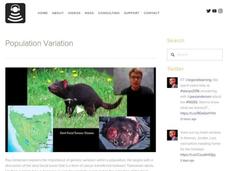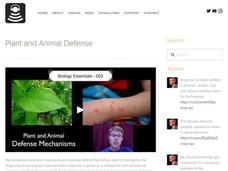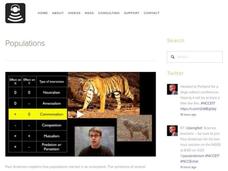Bozeman Science
Circulatory System
The average person's heart beats about three billion times during their lifetime. In this circulatory system video, learners briefly see the difference between an open and closed circulatory system. The rest of the video focuses on the...
Bozeman Science
The Brain
There are 100,000 miles of blood vessels in the brain—wow! In this brain video, viewers see how the brain has evolved from simple to complex organisms. The instructor explains the 17 different structures of the brain and their...
Bozeman Science
Muscular System
To take one step, the body uses about 200 muscles. In the video, learners see the difference between the three types of muscles found in the human body—skeletal/striated, smooth, and cardiac. The instructor then explains, in detail, how...
Bozeman Science
Biology
In this biology video, the instructor introduces the four main concepts behind Biology approved by The College Board—evolution, free energy, information, and systems. Individuals then listen to and see descriptions and examples of each...
Bozeman Science
Plants
Use a biology video to focus on four main groups of plants: bryophytes, ferns, gymnosperms, and anglosperms. It explains the parts of plants, life cyles, evolution of plants, and even touches upon sporophyte and gametophyte.
Bozeman Science
Natural Selection
Between 1968 and 2002, the total number of peppered moths decreased by almost two thirds, although scientists do now know why. In the 10th video of the series, the instructor defines evolution as any changes to a gene pool. Scholars then...
Bozeman Science
r and K Selection
Some species have one gender that is r-selected while the other is K-selected. A video focuses on growth rate and the difference between r-selected species and K-selected species. It includes a discussion of fecundity and carrying...
Bozeman Science
Population Variation
Tasmanian devils are scavengers who eat dead animals including the bones and fur. A video begins with cancer in Tasmanian devils to demonstrate the importance of genetic variation. Then examples such as the black-footed ferret and AIDS...
Bozeman Science
Environmental Matter Exchange
Why did carbon marry hydrogen? They bonded well from the minute they met. Here is a video that focuses on the essential chemicals for life: water, carbon, nitrogen, and phosphorus. It relates each of these to macromolecules and the way...
Bozeman Science
Ecosystem Change
Climate change has happened throughout the history of the planet, and the video uses examples from continental drift to modern airplanes as measurable examples. It begins with how climate change will impact systems on the...
Bozeman Science
Biodiversity
"The one process ongoing that will take millions of years to correct is the loss of genetic and species diversity by destruction of natural habitats" - E.O. Wilson. Here is a video that discusses biodiversity at multiple levels from...
Bozeman Science
Plant and Animal Defense
Explain the defense systems of both plants and animals against pathogens with a biology video. It covers the disruption of the immune system through hypersensitive responses, normal responses, nonspecific immune responses, as well as the...
Bozeman Science
Viral Replication
Explain how viruses use the lytic and lysogenic cycles with an explanatory video. The resource also describes retroviruses and the virulence of bacteria.
Bozeman Science
Examples of Natural Selection
Viewers explore real-world examples of both evolution and natural selection as the instructor discusses changes to the environment, mutations causing changes in phenotypes and changing the fitness in organisms, and how humans are...
Bozeman Science
Evidence for Evolution II
Some scientists believe humans are no longer evolving and have reached their evolutionary peak. In the video, scholars explore Darwin and his published work, The Origin of Species. The instructor discusses Darwin's ideas of biogeography,...
Bozeman Science
Scientific Evidence for Evolution
Humans share about 50% of their genes with a banana. In the video, scholars analyze the scientific evidence for evolution. The instructor spends time discussing Darwin and biogeography, fossils, and homologous structures. Scholars then...
Bozeman Science
Cladograms
No, a cladogram is not a new mass measurement beyond kilo. In the video, scholars watch as a simple cladogram is constructed consisting of seven organisms with shared characteristics. From this, the instructor asks where a new organism...
Bozeman Science
Law of Superposition
Scholars learn how rock layers, shift, and move over time. The instructor shows viewers how to solve geologic problems to determine the order of rock layers from oldest to youngest through a drawing video and then actual...
Bozeman Science
Secret of Life
Explore how DNA, genes, and proteins are tied together to make life. Scholars learn about the central dogma, connecting DNA, which is inherited, to RNA and then to proteins, all which make the diversity of life today.
Bozeman Science
Stickleback Evolution
About 70 percent of the genes of the stickleback fish are the same as humans. In the video, scholars further explore the stickleback fish and its history, from being removed from Loberg Lake to their change and comeback. Over time, these...
Bozeman Science
The Operon
Operons operate on sections of genes. A video begins by explaining that operons are located mainly in bacteria, specifically focusing on lac operon. This lac operon, found in E.coli, breaks down lactose. It then shows how lac operon...
Bozeman Science
Beginner's Guide to Punnett Squares
Show learners how to apply genotypes of parents to a Punnett square to determine potential genotypes and phenotypes of offspring with a video that explores monohybrid crosses and then complete a dihybrid cross as well.
Bozeman Science
Populations
The largest concentration of free-roaming wildlife in the continental United States is found in Yellowstone National Park. A video describes the three main types of population interactions: mutualism, commensalism, and parasitism. It...
Bozeman Science
Population Modeling
Are you Excelent with spread sheets? Video begins with an explanation of populations and life cycles of both plants and animals. Then it walks through how to model generations of a population by using a spreadsheet. It is the...























